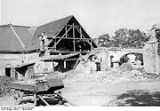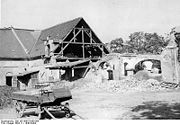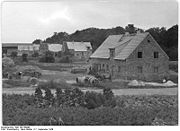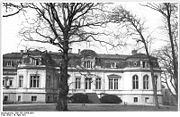
Breitenfeld, Leipzig
Encyclopedia
The village of Breitenfeld belongs to the city of Leipzig. The village lies in the vicinity of the old road to Landsberg. On the south, it borders of the borough of Gohlis
, in the west on Lindenthal and in the east, on Wiederitzsch.
 Breitenfeld was first mentioned in documents in 1271, as part of the estate of the Margrafs of Landsberg. When the elder Dietrich of Landsberg
Breitenfeld was first mentioned in documents in 1271, as part of the estate of the Margrafs of Landsberg. When the elder Dietrich of Landsberg
died, his illegitimate son, Dietrich II, inherited the property. The property of Breitenfeld, which included Wiederitzsch and Lindenthal, came under the legal jurisdiction of the Bishopric of Merseburg
.
After the Reformation
, Breitenfeld came into the possession of different Saxon noble families. These occupants were counted among the Saxon noble houses, and usually had their seat at Landsberg.
 During the Thirty Years War, in 1631, in the Battle of Breitenfeld (1631)
During the Thirty Years War, in 1631, in the Battle of Breitenfeld (1631)
, an alliance of Saxon and Swedish forces, under the command of Gustav Adolf, the king of Sweden
, with additional German allies and mercenaries, defeated the armies of the Catholic League
and the Habsburgs, commanded by Johann Tserclaes, Count of Tilly. In 1642, in a second Battle of Breitenfeld (1642)
, the troops of Sweden and Saxony again defeated the imperial troops.
 At the Battle of Nations in 1813, the Prussian general Gebhard Leberecht von Blücher
At the Battle of Nations in 1813, the Prussian general Gebhard Leberecht von Blücher
established his command post in the Breitenfeld mill, from which he coordinated the attacks on Napoleon's French troops positioned in Möckern and Gohlis.
In 1856, the patrimonial authority was relinquished and Breitenfeld acquired local autonomy within the duchy of Saxony, as a community with its own village council. In 1923, the village formed part of the conjoined community of Lindenthal, and in 1999, joined with the city of Leipzig. Since 2002, Breitenfeld has been the main home of the Leipzig animal rescue, and the city's fairgrounds and exhibition hall is located at the village.
 In the eastern portion of the village, a monument to Gustav Adolf reminds viewers of the Battle of Breitenfeld, 1631. It was erected in 1831 on the two hundredth anniversary of the battle and bears the following inscription:
In the eastern portion of the village, a monument to Gustav Adolf reminds viewers of the Battle of Breitenfeld, 1631. It was erected in 1831 on the two hundredth anniversary of the battle and bears the following inscription:
Gohlis
Gohlis is an area in the north-west of the city of Leipzig, Germany. Only in 1890 was it absorbed into the city. It is known as the place, where Friedrich Schiller worked on the second act of Don Carlos and wrote his first edition of the famous Ode to Joy....
, in the west on Lindenthal and in the east, on Wiederitzsch.
History

Dietrich I, Margrave of Lusatia
Theodoric I was the Margrave of Lusatia from 1156 until his death. He was the second surviving son of Conrad, Margrave of Meissen and Lusatia from the House of Wettin, from whom he inherited the latter territory including Eilenburg and Landsberg in 1156, while his elder brother Otto the Rich...
died, his illegitimate son, Dietrich II, inherited the property. The property of Breitenfeld, which included Wiederitzsch and Lindenthal, came under the legal jurisdiction of the Bishopric of Merseburg
Bishopric of Merseburg
The Bishopric of Merseburg was a episcopal see on the eastern border of the mediæval Duchy of Saxony with its centre in Merseburg, where Merseburg Cathedral was constructed...
.
After the Reformation
Protestant Reformation
The Protestant Reformation was a 16th-century split within Western Christianity initiated by Martin Luther, John Calvin and other early Protestants. The efforts of the self-described "reformers", who objected to the doctrines, rituals and ecclesiastical structure of the Roman Catholic Church, led...
, Breitenfeld came into the possession of different Saxon noble families. These occupants were counted among the Saxon noble houses, and usually had their seat at Landsberg.

Battle of Breitenfeld (1631)
The Battle of Breitenfeld or First Battle of Breitenfeld , was fought at the crossroads villages of Breitenfeld , Podelwitz , and Seehausen , approximately five miles northwest of the walled city of Leipzig on September 17 , or September 7 The Battle of Breitenfeld or First Battle of Breitenfeld...
, an alliance of Saxon and Swedish forces, under the command of Gustav Adolf, the king of Sweden
Sweden
Sweden , officially the Kingdom of Sweden , is a Nordic country on the Scandinavian Peninsula in Northern Europe. Sweden borders with Norway and Finland and is connected to Denmark by a bridge-tunnel across the Öresund....
, with additional German allies and mercenaries, defeated the armies of the Catholic League
Catholic League (German)
The German Catholic League was initially a loose confederation of Roman Catholic German states formed on July 10, 1609 to counteract the Protestant Union , whereby the participating states concluded an alliance "for the defence of the Catholic religion and peace within the Empire." Modeled...
and the Habsburgs, commanded by Johann Tserclaes, Count of Tilly. In 1642, in a second Battle of Breitenfeld (1642)
Battle of Breitenfeld (1642)
The Second Battle of Breitenfeld, also known as the First Battle of Leipzig , took place at Breitenfeld , Germany, during the Thirty Years' War— fully eleven years after the first battle at the crossroads village had unbottled the Swedish forces under Gustavus II Adolphus wherein he had...
, the troops of Sweden and Saxony again defeated the imperial troops.

Gebhard Leberecht von Blücher
Gebhard Leberecht von Blücher, Fürst von Wahlstatt , Graf , later elevated to Fürst von Wahlstatt, was a Prussian Generalfeldmarschall who led his army against Napoleon I at the Battle of the Nations at Leipzig in 1813 and at the Battle of Waterloo in 1815 with the Duke of Wellington.He is...
established his command post in the Breitenfeld mill, from which he coordinated the attacks on Napoleon's French troops positioned in Möckern and Gohlis.
In 1856, the patrimonial authority was relinquished and Breitenfeld acquired local autonomy within the duchy of Saxony, as a community with its own village council. In 1923, the village formed part of the conjoined community of Lindenthal, and in 1999, joined with the city of Leipzig. Since 2002, Breitenfeld has been the main home of the Leipzig animal rescue, and the city's fairgrounds and exhibition hall is located at the village.
Battle Monument

- „Glaubensfreiheit für die Welt, rettete bei Breitenfeld – Gustav Adolf, Christ und Held. Am 7. September 1631."
- Freedom of Belief for the World, salvaged at Breitenfeld, Gustav Adolf, Christian and Hero. 7 September 1631.

